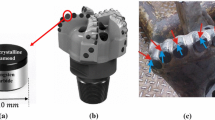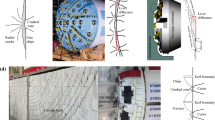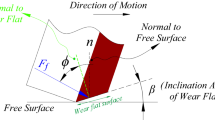Abstract
A vast majority of experimental researches focuses on the cutting action of a sharp cutter, while there has been limited experimental work devoted to the study of the contact process at the wear flat-rock interface. The specific objective of this study is to determine the effect of the wear flat inclination angle (\(\beta\)) with respect to the cutter velocity vector (\(\varvec{v}\)) on both the contact stress (\(\sigma\)) and friction coefficient (\(\mu\)) mobilized at the wear flat-rock interface. An extensive and comprehensive set of cutting experiments was carried out on thirteen different sedimentary quarry rock samples using a state-of-the-art rock cutting equipment. A unique cutter holder was purposely designed and manufactured along with a precise experimental protocol implemented in order to change the back rake angle and therefore the inclination \(\beta\) by steps of \(0.10^{\circ }\). The experimental observations confirm the existence of three regimes of frictional contact (identified as elastic, elasto-plastic and plastic) for all rock samples. Further, the results suggest that the scaled contact stress is predominantly controlled by a dimensionless number \(\eta =\frac{E^{*}\tan \beta }{q}\) with \(E^{*}\) the plane strain elastic modulus and q the rock strength.






















Similar content being viewed by others
Abbreviations
- F :
-
Total force acting on the cutter
- \(F_\mathrm{c}, F_\mathrm{f}\) :
-
Total cutting and frictional contact forces
- \(F_\mathrm{cn}, F_\mathrm{cs}\) :
-
Normal and tangential components of the cutting force
- \(F_\mathrm{fn}, F_\mathrm{fs}\) :
-
Normal and tangential components of the frictional contact force
- \(\tilde{F_\mathrm{fn}}, \tilde{F_\mathrm{fs}}\) :
-
Projected components of the contact force components
- d :
-
Depth of cut
- \(A_\mathrm{c}\) :
-
Cross-sectional area of groove traced by cutter
- \(A_\mathrm{f}\) :
-
Wear flat area
- \(\omega\) :
-
Width of cutter
- q :
-
Uni-axial compressive strength of the rock material
- \(\zeta\) :
-
Ratio of normal component to tangential component of cutting force
- \(\varepsilon\) :
-
Intrinsic specific energy
- \(\theta\) :
-
Back rake angle
- \(\theta _{*}\) :
-
Initial back rake angle
- \(\varDelta \theta _{*}\) :
-
Relative increment of back rake angle
- \(\psi\) :
-
Interfacial friction angle
- \(\varvec{v}\) :
-
Horizontal cutting velocity
- \(\phi\) :
-
Friction angle
- \(\mu\) :
-
Friction coefficient
- \(\sigma\) :
-
Normal contact stress
- \(\ell\) :
-
Length of wear flat surface
- \(\beta\) :
-
Inclination angle of wear flat with respect to velocity vector
- E :
-
Elastic modulus of the rock material
- \(\nu\) :
-
Poisson’s ratio of the rock material
- \(\varphi\) :
-
Internal friction angle of the rock material
- \(\prod\) :
-
Scaled contact stress
- \(\eta\) :
-
Dimensionless number
- \(\chi\) :
-
Chamfer angle
- \(\varDelta z\) :
-
Relative vertical displacement of spindle
References
Adachi JI (1996) Frictional contact in rock cutting with blunt tools. M.Sc Thesis, Civil Engineering, University of Minnesota
Adachi JI, Detournay E, Drescher A (1996) Determination of rock strength parameters from cutting tests. Proceedings of 2nd North American Rock Mechanics Symposium (NARMS 1996), Montreal, Balkema, Rotterdam, pp 1517–1523
Akbari B, Miska S (2016) The effects of chamfer and back rake angle on PDC cutters friction. J Nat Gas Sci Eng 35:347–353. https://doi.org/10.1016/j.jngse.2016.08.043
Akbari B, Miska SZ (2017) Relative significance of multiple parameters on the mechanical specific energy and frictional responses of polycrystalline diamond compact cutters. J Energy Res Technol 139(2):022,904. https://doi.org/10.1115/1.4034291
Alehossein H, Detournay E, Huang H (2000) An analytical model for the indentation of rocks by blunt tools. Rock Mech Rock Eng 33(4):267–284. https://doi.org/10.1007/s006030070003
Almenara J, Detournay E (1992) Cutting experiments in sandstones with blunt PDC cutters. Rock characterization: ISRM symposium, Eurock’92, Chester, UK, 14–17 September 1992, Thomas Telford Publishing, pp 215–220
Bellin F, Dourfaye A, King W, Thigpen M (2010) The current state of PDC bit technology. World oil 231(9):41–46
Besselink B (2008) Analysis and validation of self-excited drill string oscillations. M.Sc Thesis, Department of Mechanical Engineering, Eindhoven University of Technology
Challamel N, Sellami H (1998) Application of yield design for understanding rock cutting mechanism. SPE/ISRM Rock Mechanics in Petroleum Engineering, Society of Petroleum Engineers, https://doi.org/10.2118/47340-MS
Che D, Han P, Guo P, Kornel E (2012) Issues in polycrystalline diamond compact cutter-rock interaction from a metal machining point of view-part I: temperature, stresses, and forces. J Manuf Sci Eng. https://doi.org/10.1115/1.4007468
Che D, Zhu WL, Ehmann KF (2016) Chipping and crushing mechanisms in orthogonal rock cutting. Int J Mech Sci 119:224–236. https://doi.org/10.1016/j.ijmecsci.2016.10.020
Cheatham CA, Loeb DA (1985) Effects of field wear on PDC bit performance. SPE/IADC Drilling Conference, Society of Petroleum Engineers, New Orleans, Louisiana, 5–8 March. https://doi.org/10.2118/13464-MS
Chen LH, Labuz JF (2006) Indentation of rock by wedge-shaped tools. Int J Rock Mech Min Sci 43(7):1023–1033. https://doi.org/10.1016/j.ijrmms.2006.03.005
Coudyzer C, Richard T (2005) Influence of the back and side rake angles in rock cutting. AADE 2005 National Technical Conference and Exhibition, Wyndam Greenspoint, Houston, TX, pp 5–7
Dagrain F (2006) Etude des mecanismes de coupe des roches avec couteaux uses - approche des mécanismes de frottement sous les couteaux par le concept du troisième corps. Ph.D Thesis, Faculté Polytechnique de Mons
Dagrain F, Detournay E, Richard T (2001) Influence of cutter geometry in rock cutting. DC Rocks 2001, The 38th US Symposium on Rock Mechanics (USRMS), American Rock Mechanics Association, Washington, D.C., 7–10 July 2001
Detournay E, Defourny P (1992) A phenomenological model for the drilling action of drag bits. Int J Rock Mech Min Sci Geomech Abstr 29(1):13–23. https://doi.org/10.1016/0148-9062(92)91041-3
Detournay E, Richard T, Shepherd M (2008) Drilling response of drag bits: theory and experiment. Int J Rock Mech Min Sci 45(8):1347–1360. https://doi.org/10.1016/j.ijrmms.2008.01.010
Fairhurst C, Lacabanne W (1957) Hard rock drilling techniques. Mine Quarry Eng 23:157–161
Geoffroy H (1996) Etude de l’interaction roche/outil de forage: Influence de l’usure sur les parametres de coupe. Ph. D. Thesis, Ecole Polytechique Paris
Geoffroy H, Minh DN (1997) Study on interaction between rocks and worn PDC’s cutter. Int J Rock Mech Min Sci 34(3–4):95e1–95e15. https://doi.org/10.1016/S1365-1609(97)00036-1
Gerbaud L, Menand S, Sellami H (2006) PDC bits: all comes from the cutter rock interaction. IADC/SPE Drilling Conference, 21–23 February, Miami, Florida, USA, Society of Petroleum Engineers. https://doi.org/10.2118/98988-MS
Glowka DA (1987) Development of a method for predicting the performance and wear of PDC (polycrystalline diamond compact) drill bits. Tech. rep., Sandia National Labs., Albuquerque, NM (USA)
Glowka DA (1989) Use of single-cutter data in the analysis of PDC bit designs: Part 1-development of a PDC cutting force model. J Petrol Technol 41(08):797–849. https://doi.org/10.2118/15619-PA
Hood M, Alehossein H (2000) A development in rock cutting technology. Int J Rock Mech Min Sci 37(1):297–305. https://doi.org/10.1016/S1365-1609(99)00107-0
Huang H, Damjanac B, Detournay E (1997) Numerical modeling of normal wedge indentation in rocks with lateral confinement. Int J Rock Mech Min Sci 34(3–4):64.e1–64.e15. https://doi.org/10.1016/S1365-1609(97)00169-X
Huang H, Damjanac B, Detournay E (1998) Normal wedge indentation in rocks with lateral confinement. Rock Mech Rock Eng 31(2):81–94. https://doi.org/10.1007/s006030050010
Johnson KL (1985) Contact mechanics. Cambridge University Press, Cambridge
Kalantari S, Hashemolhosseini H, Baghbanan A (2018) Estimating rock strength parameters using drilling data. Int J Rock Mech Min Sci 104:45–52. https://doi.org/10.1016/j.ijrmms.2018.02.013
Lasserre C (1994) Rock friction apparatus: Realisation de tests de coupe sur roches a l’aide d’un outil PDC. Tech. rep., Institut en Sciences et Technologies Geophysique et Geotechniques, Universite de Paris VI, Paris, France
Lhomme T (1999) Frictional contact at a rock-tool interface: an experimental study. M. Sc Thesis, University of Minnesota
Li XB, Summers DA, Rupert G, Santi P (2001) Experimental investigation on the breakage of hard rock by the PDC cutters with combined action modes. Tunn Undergr Space Technol 16(2):107–114. https://doi.org/10.1016/S0886-7798(01)00036-0
Liu H, Kou S, Lindqvist PA (2002) Numerical simulation of the fracture process in cutting heterogeneous brittle material. Int J Numer Anal Meth Geomech 26(13):1253–1278. https://doi.org/10.1002/nag.243
Liu W, Zhu X, Jing J (2018) The analysis of ductile-brittle failure mode transition in rock cutting. J Petrol Sci Eng 163:311–319. https://doi.org/10.1016/j.petrol.2017.12.067
Menand S, Gerbaud L, Dourfaye A (2005) PDC bit technology improvements increase efficiency, bit life. Drilling Contractor pp 52–54. https://hal-mines-paristech.archives-ouvertes.fr/hal-00584232
Mensa-Wilmot G (2013) Impact resistant PDC drill bit. US Patent 8,448,725
Naeimipour A, Rostami J (2017) Estimation of rock in-situ strength using rock strength borehole probe (rsbp). 51st US Rock Mechanics/Geomechanics Symposium. American Rock Mechanics Association
Perneder L, Detournay E, Downton G (2012) Bit/rock interface laws in directional drilling. Int J Rock Mech Min Sci 51:81–90. https://doi.org/10.1016/j.ijrmms.2012.01.008
Richard T (1999) Determination of rock strength from cutting tests. M. Sc Thesis, Faculty of the Graduate School of the University of Minnesota, Minneapolis, Minnesota, U.S.A
Richard T, Detournay E, Drescher A, Nicodeme P, Fourmaintraux D (1998) The scratch test as a means to measure strength of sedimentary rocks. SPE/ISRM Eurock 98. Society of Petroleum Engineers, Trondheim, Norway, SPE 47196:1–8. https://doi.org/10.2118/47196-MS
Richard T, Coudyzer C, Desmette S (2010) Influence of groove geometry and cutter inclination in rock cutting. 44th US Rock Mechanics Symposium and 5th US-Canada Rock Mechanics Symposium. American Rock Mechanics Association
Richard T, Dagrain F, Poyol E, Detournay E (2012) Rock strength determination from scratch tests. Eng Geol 147–148:91–100. https://doi.org/10.1016/j.enggeo.2012.07.011
Rostam Sowlat I (2017) Effect of cutter and rock properties on the frictional contact in rock cutting with blunt tools. PhD thesis, Curtin University
Rostamsowlat I (2018) Effect of cutting tool properties and depth of cut in rock cutting: an experimental study. Rock Mech Rock Eng. https://doi.org/10.1007/s00603-018-1440-2
Rostamsowlat I, Richard T, Evans B (2018) An experimental study of the effect of back rake angle in rock cutting. Int J Rock Mech Min Sci. In press
Theodoridou M, Dagrain F, Ioannou I (2015) Micro-destructive cutting techniques for the characterization of natural limestone. Int J Rock Mech Min Sci 76:98–103. https://doi.org/10.1016/j.ijrmms.2015.02.012
Warren TM, Sinor LA (1994) PDC bits: what’s needed to meet tomorrow’s challenge. University of Tulsa Centennial Petroleum Engineering Symposium, 29-31 August, Tulsa, Oklahoma, Society of Petroleum Engineers
Wojtanowicz A, Kuru E (1993) Mathematical modeling of PDC bit drilling process based on a single-cutter mechanics. J Energy Res Technol 115(4):247–256. https://doi.org/10.1115/1.2906429
Xiao Y, Hurich C, Butt SD (2018) Assessment of rock-bit interaction and drilling performance using elastic waves propagated by the drilling system. Int J Rock Mech Min Sci 105:11–21. https://doi.org/10.1016/j.ijrmms.2018.02.006
Yadav S, Saldana C, Murthy TG (2018) Experimental investigations on deformation of soft rock during cutting. Int J Rock Mech Min Sci 105:123–132. https://doi.org/10.1016/j.ijrmms.2018.03.003
Zhou Y, Detournay E (2014) Analysis of the contact forces on a blunt PDC bit. 48th U.S. Rock Mechanics/Geomechanics Symposium, 1–4 June, Minneapolis, Minnesota. American Rock Mechanics Association
Zhou Y, Lin JS (2013) On the critical failure mode transition depth for rock cutting. Int J Rock Mech Min Sci 62:131–137. https://doi.org/10.1016/j.ijrmms.2013.05.004
Zhou Y, Lin JS (2014) Modeling the ductile-brittle failure mode transition in rock cutting. Eng Fract Mech 127:135–147. https://doi.org/10.1016/j.engfracmech.2014.05.020
Zhou Y, Zhang W, Gamwo I, Lin JS (2017) Mechanical specific energy versus depth of cut in rock cutting and drilling. Int J Rock Mech Min Sci 100:287–297. https://doi.org/10.1016/j.ijrmms.2017.11.004
Zijsling D (1984) Analysis of temperature distribution and performance of polycrystalline diamond compact bits under field drilling conditions. SPE annual technical conference and exhibition, 16–19 September, Houston, Texas. Society of Petroleum Engineers
Acknowledgements
The first author would like to thank Joel Sarout and Jeremie Dautriat at CSIRO (Commonwealth Scientific and Industrial Research Organisation) for granting access to Rock Mechanics Testing laboratory, research facilities, and particularly rock samples. The authors would like to thank Prof. Emmanuel Detournay at the University of Minnesota for his valuable and fruitful discussions. A special thanks to Gregory Lupton and Stephen Banks at CSIRO for their assistance in the design of cutter holder and tailored data acquisition system, respectively. The work has been supported by the Deep Exploration Technologies Cooperative Research Centre whose activities are funded by the Australian Government’s Cooperative Research Centre Programme. This is DET CRC Document 2017/1032.
Author information
Authors and Affiliations
Corresponding author
Appendices
Appendix A: Physical and mechanical properties of rock samples used for cutting tests
Appendix B: Procedures to determine the physical and mechanical proprietors of rock samples
A compression test machine (manufactured by Wykeham Farrance) was used to measure the uni-axial compressive strength (q), Young’s modulus (E), Poisson’s ratio (\(\nu\)), and density (\(\rho\)) of the rock samples used in this research. This machine is a displacement controlled machine which comprises of the main mechanical parts: a load frame, a load cell, two strain gauges for radial strain (\(\epsilon _\mathrm{r}\)) which have been manufactured by CSIRO, two compression platens, a control system, a gear box and two LVDTs (Linear variable displacement transducers) for axial strain (\(\epsilon _\mathrm{a}\)). The rock samples were cut into cylindrical shapes with length over diameter ratio of approximately 2.2. The rock sample was set up in the compression test machine with transducers in place to measure sample axial and radial deformations and axial load. Each core plug was tested unsaturated. Each sample was axially loaded under a constant average axial strain rate 0.5% giving a loading rate of 0.259 mm/min for both Bentheimer and Boise and 0.014 mm/min for all other rocks until the samples failed. The Young’s modulus (E) and Poisson’s ratio (\(\nu\)) were determined from the tangential slope of the curve of deviatoric stress versus average axial strain and the tangential slope of the curve of average radial strain versus average axial strain between 40 and 60% of the maximum deviatoric stress, respectively.
To measure the grain (or particle) size of the rock samples, the rock samples were crushed very gently in a mortar with a plastic pestle. An Ultrasonic Bath Cleaner was also used to ensure the grains were completely separated from each other. A Mastersizer 3000 laser diffraction particle size analyzer was used to measure the grain (particle) sizes. This machine can be used for both wet and dry particles by measuring the intensity of the light scattered as a laser beam passes through a dispersed particulate sample. Fig. 23 shows the granular distribution of some rock samples used for cutting experiments.
AP-608 Automated Porosimeter–Permeameter was used to measure the permeability and the porosity of the rock samples, see Fig. 24. This equipment measures porosity and permeability of cylindrical core samples using an inert gas (either helium or nitrogen). It uses the principle of gas expansion, as described by Boyle’s law. A known volume (reference cell volume) of gas, at a predetermined pressure, is isothermally expanded into a sample chamber. After expansion, the resulted equilibrium pressure is measured. This pressure depends on the volume of the sample chamber minus the rock grain volume, and then the porosity can be calculated. The rock permeability is also measured through the pulse decay method.
A Sanchez Technologies tri-axial rig was used to measure the internal friction angles of two rock samples (Tuffeau and Mountain Gold). This apparatus is able to reach 150 MPa confining pressure around cylindrical samples while the axial load is applied via a mobile piston. These two parameters are controlled separately using LabVIEW program during the experiment. The radial deformation is recorded via a Cantilever sensor (C-ring) that is fixed to the membrane via a screw and the axial deformation is recorded with 3 LVDTs. It is possible to add up to 20 sensors on 4 plans on the sample, inject fluid (oil, water) and heat the sample during the experiment. The magnitude of internal friction angle (\(\varphi\)) is obtained through the slope of tangential line to the Mohr circles at the confining pressures of 2, 2.5 and 5 MPa for Tuffeau limestone and 5, 10 and 15 MPa for Mountain Gold sandstone. The plots of shear stress as a function of normal stress are presented in Figs. 25 and 26.
Rights and permissions
About this article
Cite this article
Rostamsowlat, I., Richard, T. & Evans, B. Experimental investigation on the effect of wear flat inclination on the cutting response of a blunt tool in rock cutting. Acta Geotech. 14, 519–534 (2019). https://doi.org/10.1007/s11440-018-0674-1
Received:
Accepted:
Published:
Issue Date:
DOI: https://doi.org/10.1007/s11440-018-0674-1








